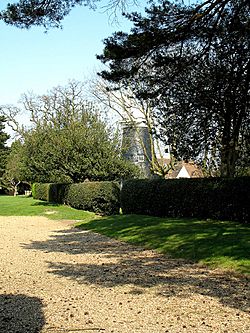Barnet Gate Mill facts for kids
Quick facts for kids Arkley Windmill |
|
|---|---|

Barnet Gate Mill.
|
|
| Origin | |
| Mill name | Barnet Gate Mill |
| Grid reference | TQ 217 953 |
| Coordinates | 51°38′35″N 0°14′35″W / 51.643°N 0.243°W |
| Operator(s) | Private |
| Year built | 1826 |
| Information | |
| Purpose | Corn mill |
| Type | tower mill |
| Storeys | Four storeys |
| No. of sails | Four sails |
| Type of sails | Two Patent sails and two Common sails |
| Windshaft | Cast iron |
| Winding | Fantail |
| Auxiliary power | Steam engine |
| No. of pairs of millstones | Three pairs |
Barnet Gate Mill, also known as Arkley Windmill, is a very old and special building. It's a type of windmill called a tower mill. This historic mill was built way back in 1823! You can find it in Barnet Gate, which is part of the London Borough of Barnet. It's a private building, so you can't visit inside. It's listed as a Grade II* listed building, meaning it's very important and protected.
Contents
The History of Barnet Gate Mill
How Old Is This Windmill?
Barnet Gate Mill was built in 1823. Some people thought it might have been built around 1800, during the Napoleonic Wars. However, there's no real proof for that idea.
Powering the Mill
Originally, the mill used wind power to grind corn. But in 1895, a steam engine was added. This meant the mill could still work even on days with no wind. The mill kept grinding with wind power until 1918, though by then it only used two of its sails.
Restoring the Mill
The windmill has been repaired and made new a few times. In 1930, it got a big makeover. A new cap (the top part that turns), a fantail (which helps the cap turn into the wind), and a walkway around the cap were all built. A skilled person called a millwright named Thomas Hunt did this work. Later, in 1985, the two missing sails were put back on the mill.
What Barnet Gate Mill Looks Like
Outside the Mill
Barnet Gate Mill is a tower mill, which means it has a tall, round stone or brick tower. It has four main levels inside. The very top of the mill is shaped like a dome, which is called an "ogee cap." There's also a gallery, or walkway, around the cap.
The Sails and How They Turn
The mill has four large arms called sails. Two of these are "Patent sails," which are more modern and easier to adjust. The other two are "Common sails," which are older and simpler. These sails are attached to a strong cast iron pole called a windshaft. The windshaft turns when the wind pushes the sails. A special part called a fantail helps the cap turn automatically to face the wind.
How the Mill's Machinery Works
Inside the Mill
The mill's machinery is quite clever. It might have started with a wooden windshaft and different types of sails. The current cast iron windshaft is smaller, so some parts had to be adjusted to fit.
Grinding the Corn
Inside, a large cast iron gear called a "Wallower" sits on a wooden upright shaft. This shaft then turns another big gear called the "Great Spur Wheel." This wheel used to power two pairs of millstones from below, which is called "underdrift." When the steam engine was added, a third pair of millstones was put in. Today, only one pair of millstones remains in the mill. These stones are what actually grind the corn into flour.
Millers Who Worked Here
Here are some of the people who operated Barnet Gate Mill over the years:
- John Whitehead (1843–1851)
- Frederick Edwards (1870–1899)
- Noah Edwards (1896–1918)

